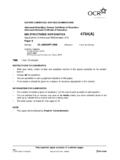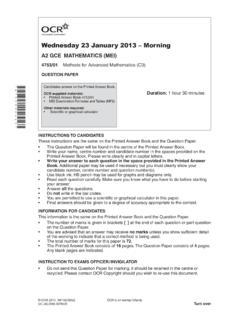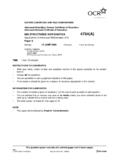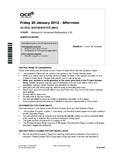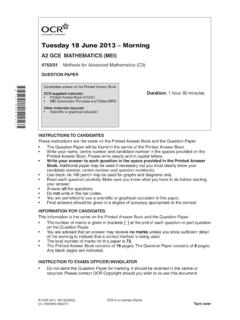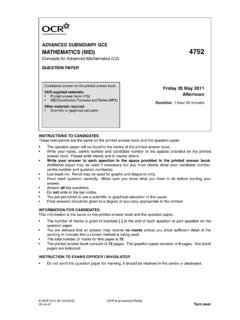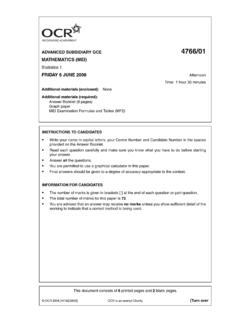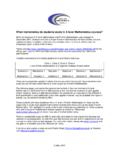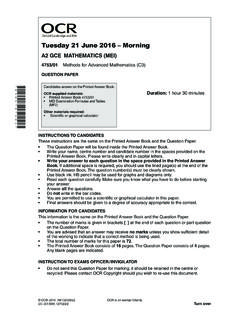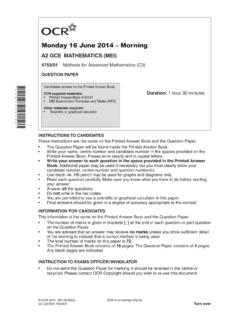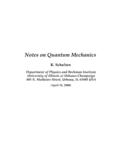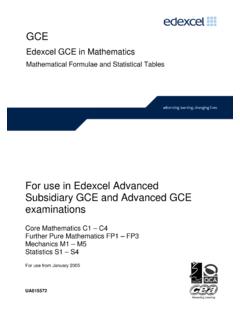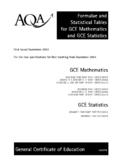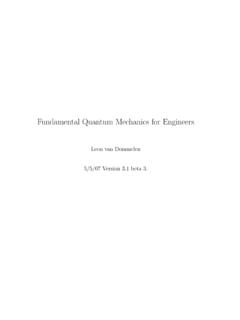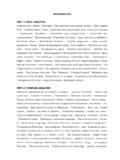Transcription of ADVANCED SUBSIDIARY GCE MATHEMATICS …
1 ADVANCED SUBSIDIARY GCEMATHEMATICS (MEI)4761/01 mechanics 1 QUESTION PAPERC andidates answer on the Printed Answer BookOCR Supplied Materials: Printed Answer Book 4761/01 MEI Examination Formulae and Tables (MF2)Other Materials Required: Scientific or graphical calculatorFriday 23 May 2008 MorningDuration:1 hour 30 minutesINSTRUCTIONS TO CANDIDATEST hese instructions are the same on the Printed Answer Book and the Question Paper. Write your name clearly in capital letters, your Centre Number and Candidate Number in the spaces providedon the Printed Answer Book. The questions are on the inserted Question Paper. Write your answer to each question in the space provided in the Printed Answer papermay be used if necessary but you must clearly show your Candidate Number, Centre Number and questionnumber(s). Use black ink.
2 Pencil may be used for graphs and diagrams only. Read each question carefully and make sure that you know what you have to do before starting your answer. Answerallthe questions. Donotwrite in the bar codes. You are permitted to use a graphical calculator in this paper. Final answers should be given to a degree of accuracy appropriate to the context. The acceleration due to gravity is denoted bygm s 2. Unless otherwise instructed, when a numerical valueis needed, useg= FOR CANDIDATESThis information is the same on the Printed Answer Book and the Question Paper. The number of marks is given in brackets[ ]at the end of each question or part question on the QuestionPaper. You are advised that an answer may receiveno marksunless you show sufficient detail of the working toindicate that a correct method is being used.
3 The total number of marks for this paper is72. The Printed Answer Book consists of12pages. The Question Paper consists of8pages. Any blank pagesare TO EXAMS OFFICER / INVIGILATOR Do not send this Question Paper for marking; it should be retained in the centre or destroyed. OCR 2008 [M/102/2649]OCR is an exempt CharityFP 0C19 Turn over2 Section A(36 marks)1 Fig. shows a circular cylinder of mass 100 kg being raisedby a light, inextensible vertical wire is negligible air kgFig. (i)Calculate the acceleration of the cylinder when the tensionin the wire is 1000 N.[3](ii)Calculate the tension in the wire when the cylinder has an upward acceleration of m s 2. [2]The cylinder is now raised inside a fixed smooth vertical tubethat prevents horizontal motion butprovides negligible resistance to the upward motion of the cylinder.
4 When the wire is inclined at 30 to the vertical, as shown in Fig. , the cylinder again has an upward acceleration of m s kgFig. tube(iii)Calculate the new tension in the wire.[3]2A particle has a position vectorr, wherer=4i 5jandiandjare unit vectors in the directions eastand north respectively.(i)Sketchron a diagram showingiandjand the origin O.[1](ii)Calculate the magnitude ofrand its direction as a bearing.[4](iii)Write down the vector that has the same direction asrand three times its magnitude.[1] OCR 20084761/01 Jun0833An object of mass 5 kg has a constant acceleration of( 12)m s 2for 0 t 4, wheretis the time inseconds.(i)Calculate the force acting on the object.[2]Whent=0, the object has position vector( 23)m and velocity(45)m s 1.(ii)Find the position vector of the object whent=4.[3]4PQ125 m0 m s 10 m s m s 210 m s 1accelerationinitial velocityFig.
5 4 Particles P and Q move in the same straight line. Particle P starts from rest and has a constantacceleration towards Q of m s 2. Particle Q starts 125 m from P at the same time and has a constantspeed of 10 m s 1away from P. The initial values are shown in Fig. 4.(i)Write down expressions for the distances travelled by P and by Q at timetseconds after the startof the motion.[2](ii)How much time does it take for P to catch up with Q and how far does P travel in this time? [5]5 Boxes A and B slide on a smooth, horizontal plane. Box A has a mass of 4 kg and box B a mass of5 kg. They are connected by a light, inextensible, horizontal wire. Horizontal forces of 9 N and 135 Nact on A and B in the directions shown in Fig. N135 NA 4 kgB 5 kgFig. 5 Calculate the tension in the wire joining the boxes.[4]6 In this question takeg= golf ball is hit from ground level over horizontal ground.
6 The initial velocity of the ball is 40 m s 1at an angle to the horizontal, where sin = and cos = Air resistance may be neglected.(i)Find an expression for the height of the ball above the groundtseconds after projection. [2](ii)Calculate the horizontal range of the ball.[4] OCR 20084761/01 Jun08[Turn over4 Section B(36 marks)7abBC8 kgFig. box of mass 8 kg is supported by a continuous light string ACBthat is fixed at A and at B and passesthrough a smooth ring on the box at C, as shown in Fig. The box is in equilibrium and the tensionin the string section AC is 60 N.(i)What information in the question indicates that the tensionin the string section CB is also 60 N?[2](ii)Show that the string sections AC and CB are equally inclined to the horizontal (so that = inFig. ).[2](iii)Calculate the angle of the string sections AC and CB to the horizontal.]
7 [5]In a different situation the same box is supported by two separate light strings, PC and QC, that aretied to the box at C. There is also a horizontal force of 10 N acting at C. This force and the anglesbetween these strings and the horizontal are shown in Fig. The box is in kgFig. N25 45 (iv)Calculate the tensions in the two strings.[8] OCR 20084761/01 Jun0858 The displacement,xm, from the origin O of a particle on thex-axis is given byx=10+36t+3t2 2t3,wheretis the time in seconds and 4 t 6.(i)Write down the displacement of the particle whent=0.[1](ii)Find an expression in terms oftfor the velocity,vm s 1, of the particle.[2](iii)Find an expression in terms oftfor the acceleration of the particle.[2](iv)Find the maximum value ofvin the interval 4 t 6.[3](v)Show thatv=0 only whent= 2 and whent=3. Find the values ofxat these times.
8 [5](vi)Calculate thedistancetravelled by the particle fromt=0 tot=4.[3](vii)Determine how many times the particle passes through O in theinterval 4 t 6.[3] OCR 20084761/01 Jun086 BLANK PAGE OCR 20084761/01 Jun087 BLANK PAGE OCR 20084761/01 Jun088 Permission to reproduce items where third-party owned material protected by copyright is included has been sought and cleared where possible. Every reasonableeffort has been made by the publisher (OCR) to trace copyright holders, but if any items requiring clearance have unwittingly been included, the publisher will bepleased to make amends at the earliest possible is part of the Cambridge Assessment Group. Cambridge Assessment is the brand name of University of Cambridge Local Examinations Syndicate (UCLES),which is itself a department of the University of Cambridge. OCR 20084761/01 Jun08 ADVANCED SUBSIDIARY GCEMATHEMATICS (MEI)4761/01 mechanics 1 PRINTED ANSWER BOOKC andidates answer on this Printed Answer BookOCR Supplied Materials: Question Paper 4761/01 (inserted) MEI Examination Formulae and Tables (MF2)Other Materials Required: Scientific or graphical calculatorFriday 23 May 2008 MorningDuration:1 hour 30 minutes**447766110011**CandidateForename CandidateSurnameCentre NumberCandidate NumberINSTRUCTIONS TO CANDIDATEST hese instructions are the same on the Printed Answer Book and the Question Paper.
9 Write your name clearly in capital letters, your Centre Number and Candidate Number in the spaces providedon the Printed Answer Book. The questions are on the inserted Question Paper. Write your answer to each question in the space provided in the Printed Answer papermay be used if necessary but you must clearly show your Candidate Number, Centre Number and questionnumber(s). Use black ink. Pencil may be used for graphs and diagrams only. Read each question carefully and make sure that you know what you have to do before starting your answer. Answerallthe questions. Donotwrite in the bar codes. You are permitted to use a graphical calculator in this paper. Final answers should be given to a degree of accuracy appropriate to the context. The acceleration due to gravity is denoted bygm s 2.
10 Unless otherwise instructed, when a numerical valueis needed, useg= FOR CANDIDATESThis information is the same on the Printed Answer Book and the Question Paper. The number of marks is given in brackets[ ]at the end of each question or part question on the QuestionPaper. You are advised that an answer may receiveno marksunless you show sufficient detail of the working toindicate that a correct method is being used. The total number of marks for this paper is72. The Printed Answer Book consists of12pages. The Question Paper consists of8pages. Any blank pagesare indicated. OCR 2008 [M/102/2649]OCR is an exempt CharityFP 0C19 Turn over2 Section A(36 marks)1 (i)1 (ii)1 (iii) OCR 200832 (i)2 (ii)2 (iii) OCR 2008 Turn over43 (i)3 (ii) OCR 200854 (i)4 (ii) OCR 2008 Turn over65 OCR 200876 (i)6 (ii) OCR 2008 Turn over8 Section B(36 marks)7 (i)7 (ii)7 (iii) OCR 200897 (iii) (continued)7 (iv) OCR 2008 Turn over108 (i)8 (ii)8 (iii)8 (iv) OCR 2008118 (v)8 (vi)8 (vii) OCR 2008 Turn over128 (vii) (continued)Copyright InformationOCR is committed to seeking permission to reproduce all third-party content that it uses in its assessment materials.
